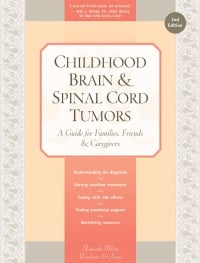Childhood Brain and Spinal Cord Tumors
Chapter 9: Venous Catheters
Do what you can, with what you have, where you are.
— Theodore Roosevelt
MANY CHILDREN WITH BRAIN OR SPINAL CORD TUMORS require intensive treatment, including surgery, chemotherapy, intravenous (IV) fluids, IV antibiotics, blood and platelet transfusions, frequent blood sampling, and sometimes IV nutrition. Venous catheters provide a very effective method for allowing entry into the large veins for intensive therapy. Venous catheters eliminate the difficulty of finding veins for IVs and allow drugs to be put directly into the heart, where they are rapidly diluted and spread throughout the body. They also reduce stress and discomfort for the child by eliminating the need for hundreds of needle sticks.
The three types of venous catheters are: external catheters, subcutaneous ports, and peripherally inserted central catheters (PICC). Other names for a venous catheter include: venous access device, right atrial catheter, implanted catheter, indwelling catheter, central line, Hickman®, Broviac®, PORT-A-CATH®, Medi-port®, and PICC line.
Table of Contents
All Guides- Introduction
- 1. Diagnosis
- 2. The Brain and Spinal Cord
- 3. Types of Tumors
- 4. Telling Your Child and Others
- 5. Choosing a Treatment
- 6. Coping with Procedures
- 7. Forming a Partnership with the Treatment Team
- 8. Hospitalization
- 9. Venous Catheters
- 10. Surgery
- 11. Chemotherapy
- 12. Common Side Effects of Chemotherapy
- 13. Radiation Therapy
- 14. Peripheral Blood Stem Cell Transplantation
- 15. Siblings
- 16. Family and Friends
- 17. Communication and Behavior
- 18. School
- 19. Sources of Support
- 20. Nutrition
- 21. Medical and Financial Record-keeping
- 22. End of Treatment and Beyond
- 23. Recurrence
- 24. Death and Bereavement
- 25. Looking Forward
- Appendix A. Blood Tests and What They Mean
- Appendix C. Books and Websites

